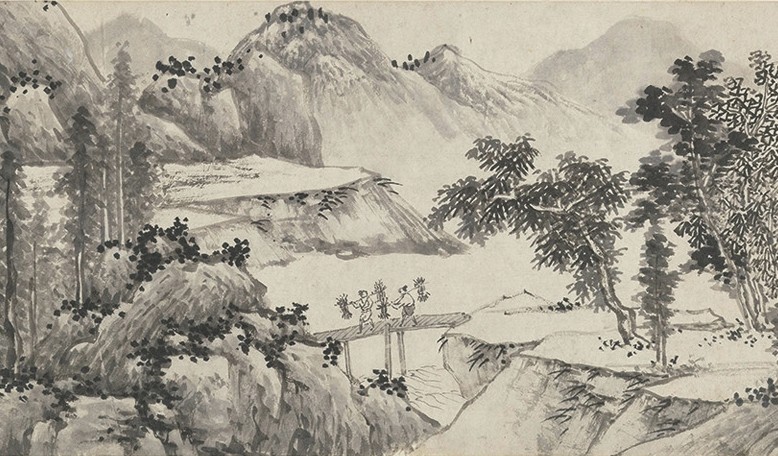
Shen Zhou's last painting, finished by his follower Wen Zhengming (1470–1559). Detail.
Shen Zhou (1427–1509), the patriarch of the Wu school of painting centered in the cosmopolitan city of Suzhou, and his preeminent follower Wen Zhengming (1470–1559) exemplified Ming literati ideals. Both men chose to reside at home rather than follow official careers, devoting themselves to self-cultivation through a lifetime spent reinterpreting the styles of Yuan scholar-painters.
Shen's most ambitious landscape composition—the scroll is over fifty-six feet (seventeen meters) long—it shows the artist systematically reinterpreting Wu Zhen's brush idiom. He devoted much of his later life to an exploration of the brush style of the fourteenth-century recluse-painter Wu Zhen (1280-1354) while striving for a new compositional monumentality. The painting remained incomplete at Shen Zhou's death. In 1546 it was rediscovered by Shen's illustrious pupil Wen Zhengming, who added finishing touches. Wen's inscription recounts: "The composition was already fully realized, but the dotting and washing had not been completed. I, his student, have now finished it. But consider my clumsy effort, how could I add to this 'sable tail'!"
The 'Wu School' was group of artists united by shared artistic theories and interests. Located in the affluent and commercial city of Suzhou, it thrived during the Ming dynasty (1368–1644). Counting among its members were both professional (commercial) artists, who focused on creating polished works with popular themes, and literati artists, who delved into more nuanced, personal expressions through poetry, calligraphy, and painting, known as the 'Three Perfections'.
The 'Wu School' derived its name from the Kingdom of Wu (222-280), one of the 'Three Kingdoms' (220-280) that the four-century-long Han dynasty fell apart into. The prosperous Kingdom of Wu, with its own culture and language, was situated in southeastern China, with its capital in present-day Nanjing. It was bordered to the north by the Yangtze River and to the east by the East China Sea.
Wu County or Wuxian 221 B.C. – December 2000) is a former county and city located in modern Suzhou City, Jiangsu Province. Its name refers to its former status as the capital of the state of Wu during the Spring and Autumn period.
The Jiangnan (South of the Yangtze river) region, particularly centered around the city of Suzhou, played a pivotal role in the flourishing of the Wu School of painting. Suzhou, located to the south of the Yangzi (Yangtze) River, was a city of immense beauty and cultural richness, which significantly influenced the artists and the artworks of the Wu School.
Suzhou, nestled between the Yangzi River and Lake Tai, provided a naturally beautiful setting, enriched with water bodies and fertile lands. The city was intricately designed with a network of small rivers and up to three hundred stone bridges, adding to its aesthetic appeal and charm.
During the Ming dynasty, Suzhou emerged as a leading center of literati culture, becoming a hub for scholars and artists. The city was adorned with temples and spacious residences with elegant walled gardens, which became sanctuaries for scholarly and artistic pursuits.
The Wu school of painting (吳門畫派) refers to a group of Chinese painters of the Ming dynasty active in the second half of the 15th and first half of the 16th centuries. They were scholar-artists who, in their “literati painting” (wenrenhua, 文人畫), perpetuated the personally expressive styles and attitudes of former artists such as the Four Masters of the Yuan dynasty, in contrast to their contemporaries of the Zhe school, who perpetuated more conservative styles.
The Wu school was named after Wu county (吳縣) in the region of Suzhou (蘇州), in Jiangsu province, where the painters worked. The historical Wu County is now part of Suzhou City. Among the artists included in the group are Shen Zhou (沈周) and his student Wen Zhengming (文徵明). Generally, their paintings are quite subtle, but that subtlety veils great variety and imagination—Wu school works are characterized by a sure, light brushstroke used to define painterly and structural complexity, learned allusions and poetic inscriptions, and very thin, delicate coloring. These artists created paintings more for their own and their peers' intellectual amusement than for a larger public. Some well-known painters, such as Tang Yin (唐寅) and Qiu Ying (仇英), lived in the area and knew the famous members of the Wu school, but they cannot easily be grouped with them because of their sometimes differing styles and interests.
The Wu School of Painting, also known as the Suzhou School, is an important painting school that originated in Suzhou, Jiangsu Province, China, during the Ming Dynasty and early Qing Dynasty. Notable figures of the Wu School include Shen Zhou, Wen Zhengming, Tang Yin (Tang Bohu), and Qiu Ying. This school primarily focused on literati painting, emphasizing individual self-expression and profound cultural cultivation, and saw significant innovation in painting techniques and themes.
Artists from the Wu School excelled in depicting natural landscapes, specializing particularly in landscape and flower-and-bird paintings. Their works typically possess strong lyrical and poetic qualities, with unique styles in composition, color application, and brushwork. The rise and development of the Wu School promoted innovation and diversification in Chinese painting, establishing literati painting as a significant genre in Chinese art.
Some key artists and their contributions to the 16th century Late Ming dynasty Wu School artists include:
Shen Zhou (1427–1509):
Wen Zhengming (1470–1559):
Tang Yin (1470–1524) and Qiu Ying (ca. 1494–1552):
The Wu School reached its zenith during the first half of the sixteenth century, with these artists playing crucial roles in its development and influence. However, after the death of Wen Zhengming, the Wu School gradually lost its prominence, and by the early seventeenth century, it was no longer a dominant force in Chinese art.
See also: The Kingdom of Wu (222-280)
A